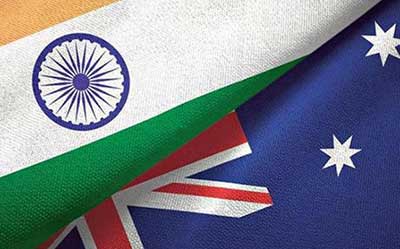Relevance: GS-2: Bilateral, regional and global groupings and agreements involving India and/or affecting India’s interests.
Key Phrases: India-Australia Economic Cooperation and Trade Agreement, early harvest pacts, India-AUS, trusted partners, comprehensive strategic partnership, Quadrilateral Security Dialogue, Indo-Pacific.
Context:
- Recently, after 10 long years of negotiations, India and Australia finally have signed the India-Australia Economic Cooperation and Trade .The Indian government rightly described it as “a watershed moment for India-Australia bilateral relations,” underlining that “consensus on such an important agreement in such a short period of time shows the mutual trust between the two countries.”
- The Australian government emphasised the pact as the single-largest government investment in Canberra’s relationship with Delhi, and suggested that “this agreement opens a big door into the world’s fastest-growing major economy for Australian farmers, manufacturers, producers and so many more.”
- The interim agreement is expected to benefit several sectors in
India:
- Including textiles, leather, furniture, jewellery, and machinery, even as it lifts tariffs on more than 85% of Australian goods exports to India.
- Pact comes at a critical time as both India and Australia are
reassessing their trade policies:
- India is trying to establish its credentials as a country ready to do business with trusted partners, and is busy finalising a number of “early harvest” pacts.
- Australia is seeking to reduce its trade dependence on China by diversifying its export markets after being at the receiving end of Beijing’s trade weaponization.
What are key strategic concerns which are strengthening the India-Australia relationship?
- India keen on signing 'Early Harvest Pacts':
- India is trying to establish its credentials as a country ready to do business with trusted partners, and is busy finalising a number of “early harvest” pacts.
- India is ready to trade with Like minded countries:
- In the past, trade was seen as a means of reducing geopolitical tensions. “Let us trade more and become friends” was the mantra of the past.
- Today, it is moving to a phase where nations want to trade only with friends and like-minded countries.
- Geopolitics is driving the trade and technology agenda, and it is this geopolitical convergence in the Indo-Pacific that is also driving the present upward trajectory in the India-Australia relations.
- Indo-Pacific maritime geography is the fulcrum around which New Delhi
and Canberra are mapping their strategic priorities:
- Recently, Australian high commissioner to India, Barry O’Farrell, has cogently articulated, “India and Australia's geography places us squarely in the middle of the world’s strategic center of gravity. And as the international system becomes more multi-polar, the region’s resilience will be tested.”
- Australia and India have, therefore, according to O’Farrell, accepted a shared responsibility to ensure a peaceful and inclusive Indo-Pacific where the rights of all states are respected regardless of their size.
- Dream of Multipolar world and Asia:
- Despite the differences over the Ukraine crisis, India and Australia remain committed to maintaining an upward trajectory in their relationship.
- A multipolar Indo-Pacific remains an objective for both New Delhi and Canberra for stepping up their geopolitical relationship.
- From government to government is now percolating into people to people as recent polling data shows how the public in India and Australia view each other as “trusted” partners.
- Evolution of India-Australia relations show consistent efforts from
both sides:
- India-Australia relations have evolved rapidly over the past few years, with the two nations signing the Mutual Logistics Sharing Agreement, allowing the two nations to use each other’s military bases for logistics support improving military partnership.
- The two countries also elevated their ties to a comprehensive strategic partnership in 2020, which is based on “mutual understanding, trust, common interests and the shared values of democracy and rule of law.”
- Both nations committed to strengthen their engagement in the Indo-Pacific for the promotion of an open, free, rules–based Indo-Pacific region supported by inclusive global and regional institutions.
- Aggressive and Assertive China:
- Amid this rising assertiveness by China, closer cooperation among like-minded nations has gathered momentum. For years, India has been trying to tread cautiously vis-à-vis China.
- Now, its calculations have changed. The choice to join hands and develop a stronger stance against China with like-minded countries no longer seems radical.
- For Australia and India, stronger partnership is essential to achieving a “free and open” Indo-Pacific.
- Development of Mini-laterals:
- Recent, Important institutional developments in the Indo-Pacific, foremost among them US president Joe Biden’s elevation of the Quad to the leaders’ level.
- Earlier, the idea of a Quadrilateral Security Dialogue was initially conceived in 2007, both New Delhi and Canberra were not willing to invest wholeheartedly in such a platform.
- Now, for the US, India, Australia, and Japan, the Quad provides a
platform to underscore their commitment to common goals:
- A rules-based international order
- Freedom of navigation
- The peaceful settlement of territorial disputes
- Today, the Quad represents a maturation in thinking by major powers in the region. And the agenda of the Quad today is wide-ranging to tackle common challenges such as Covid, climate crisis, lack of critical technologies, and terrorism by pooling in their unique strengths and moulding the future Quad.
Conclusion:
- Today, Indo-Australia issue-based relations that are more flexible, trustworthy , and political in nature compared to earlier will make their mark in the Indo-Pacific.
- Further strong bilateral ties between like-minded nations such as India and Australia will remain critical to shaping the regional security architecture.
- With the recent trade deal, New Delhi and Canberra have signalled that they take this role seriously.
Source: Observer Research Foundation
Mains Question:
Q. In the past, it was geo-economics-“Let us trade more and become friends” was the mantra, today it is geo-politics- "Let us trade with like minded countries" is the driving force. In this context, examine the recently signed India-Australia Economic Cooperation and Trade Agreement. ( 15 marks).









